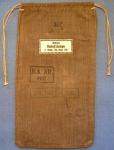-
Posts
2,962 -
Joined
-
Last visited
Content Type
Profiles
Forums
Blogs
Gallery
Events
Store
Everything posted by Chip
-
Joe, It looks like your medal that is missing the bar would take regimental bar. I assume your medal says "Treu dem Regiment". I have two loose bars that I am looking for medals for, but neither is for a regiment. I need the "Treu dem Bataillon" medal. The other bar I have is for a company. I have never seen a "Treu dem Kompanie" medal. I don't suspect there were any made for units that small, but who knows. Afterall, they did make a company level bar. Chip
-

Bayern Lanyard
Chip replied to Paul C's topic in Germany: Imperial Uniforms, Headwear, Insignia & Personal Equipment
Mike, I think that generally speaking, the Sch?tzenabzeichen does fall into that category of insignia that are somewhere between a state and a Reich's award. All of the states (and the navy), with the exception of Bavaria, wore the black, white, red cord. The fact that the Saxons don't have a green/white cord and the W?rttembergers a red/black cord somewhat verifies this notion. The use of the same cord by the navy reinforces it as well. Chip -

EK 1914 Can You ID This Badge?
Chip replied to Chuck In Oregon's topic in Germany: All Eras: The Iron Cross
Chuck, These enameled Austro Hungarian badges are quite sought after, even the patriotic/civilian versions. I would guess that one with this much visual appeal and the Iron Cross motif would be worth somewhere in the range of $40-$50, perhaps more for the right buyer. Chip -

Bayern Lanyard
Chip replied to Paul C's topic in Germany: Imperial Uniforms, Headwear, Insignia & Personal Equipment
Paul, That is definitely a Bavarian shield and if the cord is red/white/black, it is not Bavarian. Something is rotten in Denmark me thinks. Most of the cords are pictured in volume III of Das Deutsche Heer, plate 180. The major states had their own particular shield designs. The Bavarian design was like yours with the Bavarian Rautenshild and its inlaid color. The Prussian (and other states with the exception of Saxony and W?rttemberg) version had Wilhelm II's cypher as the central motif. So, there were five different shield possibilities. Silver Bavarian, gilt Bavarian, Saxon, W?rttemberg, and Prussian (et al.). Unfortunately, it seems that your cord was put together from two different examples, one Prussian and one Bavarian. Chip -

Bayern Lanyard
Chip replied to Paul C's topic in Germany: Imperial Uniforms, Headwear, Insignia & Personal Equipment
According to Das Deutsche Heer, there were ten degrees of the Sch?tzenabzeichen. This one, with a silver shield and silk (rather than wool) cord would be the sixth class. It is unclear in your picture, but it looks like the cord has red/white/black colors in it, whereas a Bavarian cord should have blue and white only. Is this one blue and white? If not, then the shield has been incorrectly added and that changes the degree and the value. If all correct, I would guess the value to be a much more conservative $175-$250, but these days no one really knows until one is offered for sale. Chip -
I suppose that this is a civilian pilot's badge? Notice that the "TC" on the cartouche of the badge is the same as that at the top of the document and the picture of the badge on the document. No military motifs on the document either. Very interesting. Chip
-

Austria-Hungary ID Weird A-H Flying badges
Chip replied to Luftmensch's topic in Austro-Hungarian Empire
Les, If the tunics came with this lot, I would love to see them. Rick, What is the difference between an Austrian and a Hungarian tunic? I did not think that there was any, save for the Hungarian crown being used on their branch collar devices. Chip -
David, Contemporary intelligence, which was not declassified until 1947! This particular copy is ink stamped on the cover "Intelligence Section A, General Staff, A.E.F.", though the work is British. By 1918 this single volume had grown to two volumes, one covering sectors and the other units. Regarding foot artillery units, I also have a compilation of information that was put together by Major Hans-Rudolf von Stein for eventual publication in "Zeitschrift f?r Heereskunde". He and Major Kling were doing a series on the German army in the world war. They got through the infantry and about half of the information, when the publication lost interest (according to von Stein) and never printed the rest. I made a copy of the manuscript back in the 1980s. After his death, some years ago, I have no idea what happened to the original manuscript (or his world class collection for that matter). The only units that are not covered are the Train troops, which the Major thought no one would ever be able to accurately chronical. Chip
-
Chris, In the "Foot Artillery Index to The German Forces in the Field. Revised, December, 1916" the 396.Battery is listed as being in the Vosges Sector: the Plaine-the Thur. No date of identification or caliber of gun is given for this unit. In the February 1918 edition of the same publication, it is listed in the Alsace sector. Not much, but perhaps some verification. Chip
-
Chris is correct, but there is no indication (at least from the uniform) that this soldier was ever in the volunteer automobile corps. Those members provided their personal vehicle for the army's use. Of course, he could have been in this group earlier, there is just no way of knowing from these photos. The fact that he is an officer might be an indication. Chip



